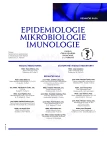West Nile fever – autochthonous human cases in South Moravia in 2018 from the epidemiological perspective
Authors:
R. Ciupek 1; P. Juráš 1; O. Šebesta 1; I. Rudolf 2; S. Šikutová 2; H. Zelená 3,4
Authors‘ workplace:
Krajská hygienická stanice Jihomoravského kraje se sídlem v Brně
1; Ústav biologie obratlovců AV ČR, v. v. i., Brno
2; Zdravotní ústav se sídlem v Ostravě, Národní referenční laboratoř pro arboviry, Ostrava
3; Univerzita obrany, Fakulta vojenského zdravotnictví, Hradec Králové
4
Published in:
Epidemiol. Mikrobiol. Imunol. 68, 2019, č. 4, s. 159-167
Category:
Original Papers
Overview
Aim: To analyse repeated detection of West Nile virus (WNV) in mosquitoes in South Moravia in correlation with the first documented autochthonous human cases of West Nile fever (WNF), focusing on epidemiological and environmental investigation.
Materials and methods: Here we report case studies of five patients with autochthonous WNF without any travel history diagnosed in South Moravia in 2018, along with in-depth epidemiological and environmental investigation. The cases were classified as confirmed based on the case definition criteria established in Commission Implementing Decision (EU) 2018/945.
Results: Between July and September 2018, a total of five human cases of West Nile virus infection were suspected and subsequently confirmed by the National Reference Laboratory for Arboviruses in Ostrava. All mosquito suspensions from the area where the first case of WNV infection was diagnosed tested WNV negative.
Conclusions: WNV circulation in South Moravia has been known since 1997 when the first human cases (probably caused by WNV lineage 1) were confirmed after floods. The presence of more serious neuroinvasive lineage 2 (WNV-2), now circulating in central and eastern Europe, was detected repeatedly in 2013, 2015, and 2016 in Cx. modestus and Cx. pipiens mosquitoes within the scope of targeted entomological surveillance. These findings were published in 2016-2018 in both the professional press and mass media. It was only a matter of time and of making the correct differential diagnosis in patients with non-specific neuroinfections before there were confirmed autochthonous human cases of WNF caused by WNV-2. These presumptions were corroborated by epidemiological investigations performed by the staff of the Regional Public Health Authority of the South Moravian Region and Academy of Sciences.
Keywords:
West Nile virus (WNV) – West Nile fever (WNF) – neuroinfections – epidemiological investigation
Sources
1. WHO. West Nile virus – Fact Sheet. Dostupné na www: https://www.who.int/news-room/fact-sheets/detail/west-nile-virus.
2. Chalupa P. Diagnostikujeme správně infekci virem West Nile? Cesk Slov Neurol N, 2007; 70/103(5): 544–546.
3. Vyhláška č. 473/2008 Sb., o epidemiologické bdělosti pro vybrané infekce, ve znění pozdějších předpisů, příloha č. 15.
4. Doporučení WNV_2018_4 pro vyřazování dárců z odběrů – riziko WNV infekce. Dostupné na www: http://www.transfuznispolecnost.cz/index.php?page=novinky.
5. Rudolf I, Blažejová H, Šebesta O, et al. West Nile virus (linie 2) v komárech na jižní Moravě – očekávání prvních autochtonních lidských případů. Epidemiol Mikrobiol Imunol, 2018;67(1):44–46.
6. ECDC publikovaná data. Dostupné na www: https://ecdc.europa.eu/en/west-nile-fever.
7. Grossner C, Marrama L, Carson M, et al. West Nile virus surveillance in Europe: moving towards an integrated animal-human-vector approach. Euro Surveill, 2017; 22(18):pii=30526.
8. EpiDat 1990–2017 a Informační systém infekčních nemocí 2018, Informační systém orgánů ochrany veřejného zdraví, Národního zdravotního informačního systému České republiky.
9. Stiassny K. Molecular basis of the problems in the serological diagnosis of flavivirus infections, Oral Session on 21st ISW-TBE, 16–17 May 2019, Vienna, Austria.
10. Hubálek Z, Halouzka J, Juřicová Z, et al. First isolation of mosquito-borne West Nile virus in the Czech Republic. Acta Virol, 1998;42(2):119–120.
11. Hubálek Z, Halouzka J, Juřicová Z. West Nile fever in Czechland. Emerg Infect Dis, 1999;5(4):594–595.
12. Rudolf I, Bakonyi T, Šebesta O, et al. West Nile virus lineage 2 isolated from Culex modestus mosquitoes in the Czech Republic, 2013: expansion of the European WNV endemic area to the North? Euro Surveill, 2014;19(31): ppi=20867.
13. Orgán ochrany veřejného zdraví – výsledky epidemiologických šetření, archiv Krajské hygienické stanice Jihomoravského kraje se sídlem v Brně.
14. Stejskal F, Zelená H, Orlíková H, et al. Doporučený postup při výskytu západonilské horečky ze dne 27. 3. 2019. Dostupné na www: http://www.mzcr.cz/Verejne/dokumenty/dopruceny-postup-pri-vyskytu-zapadonilske-horecky_17025_5.html.
15. Scaramozzino N, Crance JM, Jouan A, et al. Comparison of flavivirus universal primer pairs and development of a rapid, highly sensitive heminested reverse transcription-PCR assay for detection of flaviviruses targeted to a conserved region of the NS5 gene sequences. J Clin Microbiol, 2001;39(5):1922–1927.
16. Zelená H, Januška J, Raszka J. Micromodification of virus-neutralisation assay with vital staining in 96−well plate and its use in diagnostics of Ťahyňa virus infections. Epidemiol Mikrobiol Imunol, 2008;57(3):106−110.
17. Litzba N, Zelená H, Kreil TR, et al. Evaluation of Different Serological Diagnostic Methods for Tick-Borne Encephalitis Virus: Enzyme-Linked Immunosorbent, Immunofluorescence, and Neutralization Assay. Vector Borne Zoonotic Dis, 2014;14(2): 149–159.
18. Commission implementing decision (EU) 2018/945 of 22 June 2018 on the communicable diseases and related special health issues to be covered by epidemiological surveillance as well as relevant case definitions.
19. Rudolf I, Šebesta O. Invazní a nepůvodní druhy komárů aneb máme se u nás bát exotických nákaz? Živa, 2017;4 : 174–180.
20. Rettich F, Imrichová K, Rudolf I, et al. Virus západonilské horečky (linie 2) zjištěn v komárech Culex modestus na Třeboňsku, Zprávy centra epidemiologie a mikrobiologie (SZÚ, Praha) 2019;28(2):64–66.
21. Metodický pokyn, kterým se stanoví postup při posuzování rizika nákazy virem západonilské horečky a postup ke snížení rizika přenosu tohoto viru transfuzí .Věstník MZ ČR, 2019;5 : 4–6.
Labels
Hygiene and epidemiology Medical virology Clinical microbiologyArticle was published in
Epidemiology, Microbiology, Immunology

2019 Issue 4
Most read in this issue
- West Nile fever – autochthonous human cases in South Moravia in 2018 from the epidemiological perspective
- Epidemiology of hepatitis E virus infection
- Tuberculosis in elderly in the Czech Republic
- Estimating the impact of overweight and obesity on cancer risk in the Czech and Slovak populations
